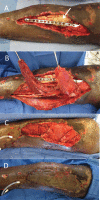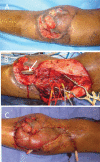Orthopedic Prosthetic Infections: Plastic Surgery Management
- PMID: 27152099
- PMCID: PMC4856528
- DOI: 10.1055/s-0036-1580728
Orthopedic Prosthetic Infections: Plastic Surgery Management
Abstract
Orthopedic prosthetic infections are potentially devastating complications. Plastic surgeons are frequently consulted to aid in the management of the soft tissue defects that are created by these infections. A review of the existing literature was performed to identify established treatment methods for soft tissue coverage of orthopedic hardware infections for a variety of anatomic locations. The following treatment guidelines and soft tissue reconstructive options were identified as viable options for the management of exposed or infected orthopedic hardware. This review provides descriptions of the various soft tissue reconstructive options available as well as adjunctive treatment methods.
Keywords: orthopedic prosthetic infections; plastic surgery.
Figures





Similar articles
-
Orthopedic Prosthetic Infections: Diagnosis and Orthopedic Salvage.Semin Plast Surg. 2016 May;30(2):66-72. doi: 10.1055/s-0036-1580730. Semin Plast Surg. 2016. PMID: 27152098 Free PMC article.
-
Wartime Soft Tissue Coverage Techniques for the Deployed Surgeon.Mil Med. 2018 Sep 1;183(9-10):e247-e254. doi: 10.1093/milmed/usy022. Mil Med. 2018. PMID: 29590411
-
What Factors Influence the Success of Medial Gastrocnemius Flaps in the Treatment of Infected TKAs?Clin Orthop Relat Res. 2016 Mar;474(3):752-63. doi: 10.1007/s11999-015-4624-z. Epub 2015 Nov 16. Clin Orthop Relat Res. 2016. PMID: 26573319 Free PMC article.
-
Bone Grafts, Bone Substitutes, and Orthobiologics: Applications in Plastic Surgery.Semin Plast Surg. 2019 Aug;33(3):190-199. doi: 10.1055/s-0039-1693020. Epub 2019 Aug 2. Semin Plast Surg. 2019. PMID: 31384235 Free PMC article. Review.
-
Antimicrobial prophylaxis in noncardiac prosthetic device recipients.Hosp Pract (1995). 2012 Feb;40(1):44-74. doi: 10.3810/hp.2012.02.947. Hosp Pract (1995). 2012. PMID: 22406882 Review.
Cited by
-
Simplified soft tissue coverage of the distal lower extremity: The reverse sural flap.OTA Int. 2023 Jul 11;6(4 Suppl):e235. doi: 10.1097/OI9.0000000000000235. eCollection 2023 Jul. OTA Int. 2023. PMID: 37448567 Free PMC article.
-
Instillation negative pressure wound therapy: An effective approach for hardware salvage.Int Wound J. 2020 Apr;17(2):387-393. doi: 10.1111/iwj.13283. Epub 2019 Dec 19. Int Wound J. 2020. PMID: 31858713 Free PMC article.
-
Instillation Negative Pressure Wound Therapy: A Role for Infected LVAD Salvage.Adv Wound Care (New Rochelle). 2019 Mar 1;8(3):118-124. doi: 10.1089/wound.2018.0832. Epub 2019 Mar 5. Adv Wound Care (New Rochelle). 2019. PMID: 31737410 Free PMC article.
-
Long-Term Wound Palliation to Manage Exposed Hardware in the Setting of Peripheral Arterial Disease.Plast Reconstr Surg Glob Open. 2019 Feb 13;7(2):e2058. doi: 10.1097/GOX.0000000000002058. eCollection 2019 Feb. Plast Reconstr Surg Glob Open. 2019. PMID: 30881824 Free PMC article.
-
Lower limb re-vascularization based on the angiosome concept with immediate-early local flap reconstruction: a case report.J Surg Case Rep. 2022 Aug 11;2022(8):rjac320. doi: 10.1093/jscr/rjac320. eCollection 2022 Aug. J Surg Case Rep. 2022. PMID: 35975230 Free PMC article.
References
-
- Gusenoff J A, Hungerford D S, Orlando J C, Nahabedian M Y. Outcome and management of infected wounds after total hip arthroplasty. Ann Plast Surg. 2002;49(6):587–592. - PubMed
-
- Panni A S, Vasso M, Cerciello S, Salgarello M. Wound complications in total knee arthroplasty. Which flap is to be used? With or without retention of prosthesis? Knee Surg Sports Traumatol Arthrosc. 2011;19(7):1060–1068. - PubMed
-
- Cetrulo C L Jr, Shiba T, Friel M T. et al.Management of exposed total knee prostheses with microvascular tissue transfer. Microsurgery. 2008;28(8):617–622. - PubMed
-
- Nahabedian M Y, Orlando J C, Delanois R E, Mont M A, Hungerford D S. Salvage procedures for complex soft tissue defects of the knee. Clin Orthop Relat Res. 1998;(356):119–124. - PubMed
LinkOut - more resources
Full Text Sources
Other Literature Sources

